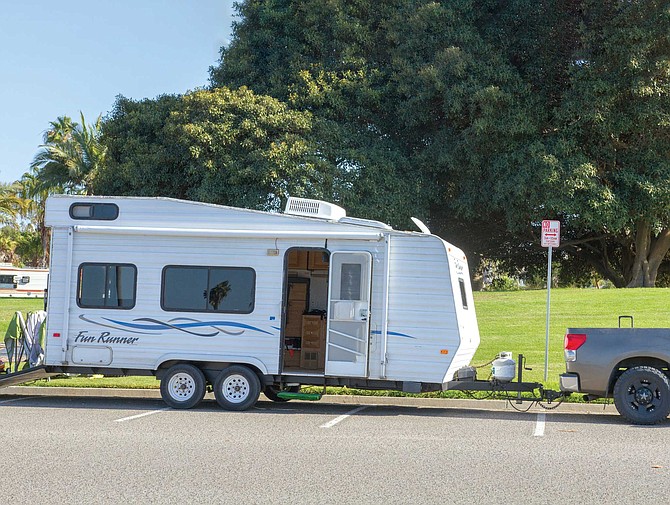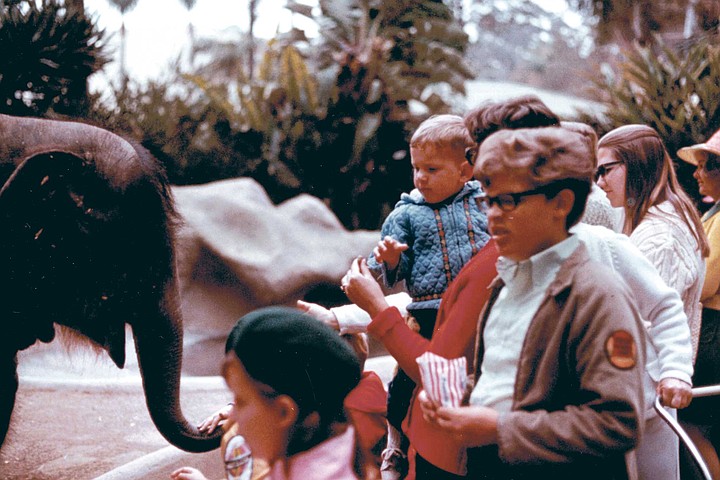 Facebook
Facebook
 X
X
 Instagram
Instagram
 TikTok
TikTok
 Youtube
Youtube

30-foot-plus RVs and trailers have gotten out of control around Mission Bay! (“San Diego cracks down on anyone living in his car,” Cover Stories, December 16) The city should have made a stipulation when they gave the campground area in De Anza Cove to Campland that they should have some affordable spots not just the ones that go for $100 a night spots.
There is also a huge lot on Seaworld Drive in old Pacific Coast Highway that has nothing on it at all and is fenced in and they could open that up and let the people park their RVs there. But the people in the RVs need to clean their acts up a bit. Nobody wants to look at a bunch of vehicles look like they came out of the Grapes of Wrath .

Over the past three years, I’ve been researching and writing a book for the Zoo about the remarkable Belle Benchley, who ran the San Diego Zoo from 1927 to 1953 as the first and only woman zoo director in the world (“Boo for the Zoo,” Cover Stories, December 3). As the face and voice of the Zoo, Belle made thousands of speeches to civic and school groups, wrote and edited ZOONOOZ for its first 20 years, appeared on radio shows and in news reels, and wrote four books, two of them best sellers, all while also managing the Zoo. As she often said, “A zoo is never finished. There are always improvements, changes, and new ideas and exhibitions. A zoo is a living thing which will continue to evolve and grow.”
As disheartening as it is for Thomas Arnold to no longer see the same exhibits, or animals displayed in the same way today as they were in his childhood, change is inevitable and necessary. Improvements arise naturally with more knowledge. In the 1920s and 1930s, the infant San Diego Zoo was considered an upstart radical by the established Eastern zoos for being the first American zoo to use bar-less moats to display animals. Another innovation was to acquire a male and female or two, instead of just a single animal, so that the animals had companionship and a family unit could form.
The San Diego Zoo quickly became known as the “nursery” of all zoos for the proliferation of offspring every year, a viable sign of contented, healthy animals.Belle wished that every Zoo visitor would just pause, be patient, and spend time quietly watching the animals being themselves. Throughout the 1930s and ‘40s, in an era when most people only saw wild animals as performers in a traveling circus,
Belle appealed to the public in newspaper interviews to not poke, prod or throw rocks at the specimens to make them move. So those “up close and personal engagements with the animals” that Arnold and Christopher Barclay miss have been modified over the years out of necessity for the benefit and protection of the animals as much as for the people.

Textbook prices have increased by 1,041% since 1977, because a small number of textbook companies have monopolized the market so much that they can raise the prices as they please (“Discount textbook shop forced out at San Diego State,” City Lights, August 24, 2016). Students suffer when they do not have access to the materials required to succeed. CALPIRG research suggests that 2 out every 25 students have failed a class due to inability to afford course materials. This is unacceptable.
I find it absolutely appalling that Aztec Shops raised the rent by 32%, preventing KB Shops from staying open and selling textbooks at a discounted price, like they had been doing for over 40 years. Like Appel stated “the original intent of the business was to provide students with alternatives’’ and now students are in a position to be taken advantage of by the textbooks market.
There are many changes needed to re-shape the US education system to allow everyone to have equal opportunity to succeed in education. We UCSD CALPIRG students are currently working to get the UC Regents to establish a grant program to incentivize faculty to use open-access resources. This is just one of many steps to take that would benefit millions of students and the communities they serve.


30-foot-plus RVs and trailers have gotten out of control around Mission Bay! (“San Diego cracks down on anyone living in his car,” Cover Stories, December 16) The city should have made a stipulation when they gave the campground area in De Anza Cove to Campland that they should have some affordable spots not just the ones that go for $100 a night spots.
There is also a huge lot on Seaworld Drive in old Pacific Coast Highway that has nothing on it at all and is fenced in and they could open that up and let the people park their RVs there. But the people in the RVs need to clean their acts up a bit. Nobody wants to look at a bunch of vehicles look like they came out of the Grapes of Wrath .

Over the past three years, I’ve been researching and writing a book for the Zoo about the remarkable Belle Benchley, who ran the San Diego Zoo from 1927 to 1953 as the first and only woman zoo director in the world (“Boo for the Zoo,” Cover Stories, December 3). As the face and voice of the Zoo, Belle made thousands of speeches to civic and school groups, wrote and edited ZOONOOZ for its first 20 years, appeared on radio shows and in news reels, and wrote four books, two of them best sellers, all while also managing the Zoo. As she often said, “A zoo is never finished. There are always improvements, changes, and new ideas and exhibitions. A zoo is a living thing which will continue to evolve and grow.”
As disheartening as it is for Thomas Arnold to no longer see the same exhibits, or animals displayed in the same way today as they were in his childhood, change is inevitable and necessary. Improvements arise naturally with more knowledge. In the 1920s and 1930s, the infant San Diego Zoo was considered an upstart radical by the established Eastern zoos for being the first American zoo to use bar-less moats to display animals. Another innovation was to acquire a male and female or two, instead of just a single animal, so that the animals had companionship and a family unit could form.
The San Diego Zoo quickly became known as the “nursery” of all zoos for the proliferation of offspring every year, a viable sign of contented, healthy animals.Belle wished that every Zoo visitor would just pause, be patient, and spend time quietly watching the animals being themselves. Throughout the 1930s and ‘40s, in an era when most people only saw wild animals as performers in a traveling circus,
Belle appealed to the public in newspaper interviews to not poke, prod or throw rocks at the specimens to make them move. So those “up close and personal engagements with the animals” that Arnold and Christopher Barclay miss have been modified over the years out of necessity for the benefit and protection of the animals as much as for the people.

Textbook prices have increased by 1,041% since 1977, because a small number of textbook companies have monopolized the market so much that they can raise the prices as they please (“Discount textbook shop forced out at San Diego State,” City Lights, August 24, 2016). Students suffer when they do not have access to the materials required to succeed. CALPIRG research suggests that 2 out every 25 students have failed a class due to inability to afford course materials. This is unacceptable.
I find it absolutely appalling that Aztec Shops raised the rent by 32%, preventing KB Shops from staying open and selling textbooks at a discounted price, like they had been doing for over 40 years. Like Appel stated “the original intent of the business was to provide students with alternatives’’ and now students are in a position to be taken advantage of by the textbooks market.
There are many changes needed to re-shape the US education system to allow everyone to have equal opportunity to succeed in education. We UCSD CALPIRG students are currently working to get the UC Regents to establish a grant program to incentivize faculty to use open-access resources. This is just one of many steps to take that would benefit millions of students and the communities they serve.